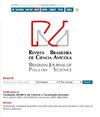凤仙花(凤仙花科)花提取物的植物化学勘探及生物活性研究
IF 1.1
4区 农林科学
Q3 AGRICULTURE, DAIRY & ANIMAL SCIENCE
引用次数: 0
摘要
凤仙花(Impatiens walleriana)是一种在花中表现出多样性和色彩多样性的植物。该植物分布广泛,易于在世界各地种植,包括自然花园,温室和公园。本研究旨在从植物化学成分的定性、对菌核菌、炭疽菌和针叶炭疽菌的抑菌活性以及对DPPH自由基的还原和对乙酰胆碱酯酶(AChE)的抑制等方面进行评价。采集了白、粉红两个品种的花和浸渍提取液。采用沉淀法或比色法,采用不同试剂进行植物化学定性分析。在培养皿中,用不同浓度的花提取物对菌丝体、gloeosporioides和acutatum进行抑菌试验。DPPH还原实验按百分比进行,并作为抗坏血酸的标准抗氧化剂。以电鳗为原料,采用百分法进行乙酰胆碱酯酶抑制试验。酚类物质、花青素、有机酸、生物碱、儿茶素、单宁、羧酸、溶血皂苷和倍半萜内酯均呈阳性。对真菌的抑制效果较好。粉色分别为10-26%、6%和9-11%,分别为菌核、gloeosporioides和acutatum。DPPH对cv的还原效果满意。粉红色占49%,其次是cv。白色的41%。抑制乙酰胆碱酯酶。粉红色,30%和cv。白人占27%。凤仙花提取物具有较好的生物活性,尤其是抗cv。粉红色的。本文章由计算机程序翻译,如有差异,请以英文原文为准。
Phytochemical prospecting and biological activities of the floral extract from [Impatiens walleriana (Hook.)] (Balsaminaceae)
Impatiens walleriana is a plant species that presents diversity and variety of colors among flowers. This plant species has wide distribution and is easily cultivable throughout the world including natural gardens, greenhouses and parks. This study aims at evaluating the floral extracts of I. walleriana in terms of their qualitative phytochemical constitution and antifungal activities on Sclerotinia sclerotiorum, Colletotrichum gloeosporioides and Colletotrichum acutatum, as well as on the reduction of DPPH free radical and on the inhibition of acetylcholinesterase (AChE). Flowers were collected from two cultivars Pink and White of I. walleriana and the extract produced by maceration. The phytochemical qualitative assay was carried out using different reagents for determination by precipitation or colorimetric alteration. The antifungal test was carried out in Petri dishes with different concentrations of floral extract on S. sclerotiorum, C. gloeosporioides and C. acutatum. The DPPH reduction assay was performed by percentage and as standard antioxidant ascorbic acid. The acetylcholinesterase inhibition test was performed in percentage using Electrophorus electricus. Positive results were observed for phenolics, anthocyanins, organic acids, alkaloids, catechins, tannins, carboxylic acids, hemolytic saponins and sesquiterpene lactones. Fungal inhibition effect was better observed for cv. Pink with 10-26%, 6% and between 9-11% on S. sclerotiorum, C. gloeosporioides and C. acutatum, respectively. The DPPH reduction activity showed satisfactory results for cv. Pink 49% followed by cv. White 41%. And for inhibition of AChE cv. Pink with 30% and cv. White with 27%. The floral extracts of Impatiens walleriana show good results for the biological activities tested, especially for cv. Pink.
求助全文
通过发布文献求助,成功后即可免费获取论文全文。
去求助
来源期刊

Brazilian Journal of Poultry Science
农林科学-奶制品与动物科学
CiteScore
1.80
自引率
9.10%
发文量
60
审稿时长
>12 weeks
期刊介绍:
A Revista Brasileira de Ciência Avícola surgiu em 1999 a partir da necessidade que a comunidade científica possuía de um periódico para veiculação e publicação de seus trabalhos, com a publicação de três números anuais.
A Revista conta hoje com um corpo editorial altamente qualificado e com artigos científicos desenvolvidos pelos maiores especialistas da área, o que a cada dia atrai mais leitores em busca de inovação e respaldo técnico.
Devido à credibilidade que conquistou pelos esforços de sus autores, relatores e revisores, a Revista ganhou caráter de coleção, sendo consultada como fonte segura de estudo desenvolvidos na Avicultura.
A partir de 2003 – volume 5 -, a Revista passou a chamar-se Brazilian Journal of Poultry Science, e todos os trabalhos passaram a ser publicados em inglês. No mesmo ano subiu para quatro o número de revistas por volume, ampliando-se assim os trabalhos publicados anualmente.
 求助内容:
求助内容: 应助结果提醒方式:
应助结果提醒方式:


